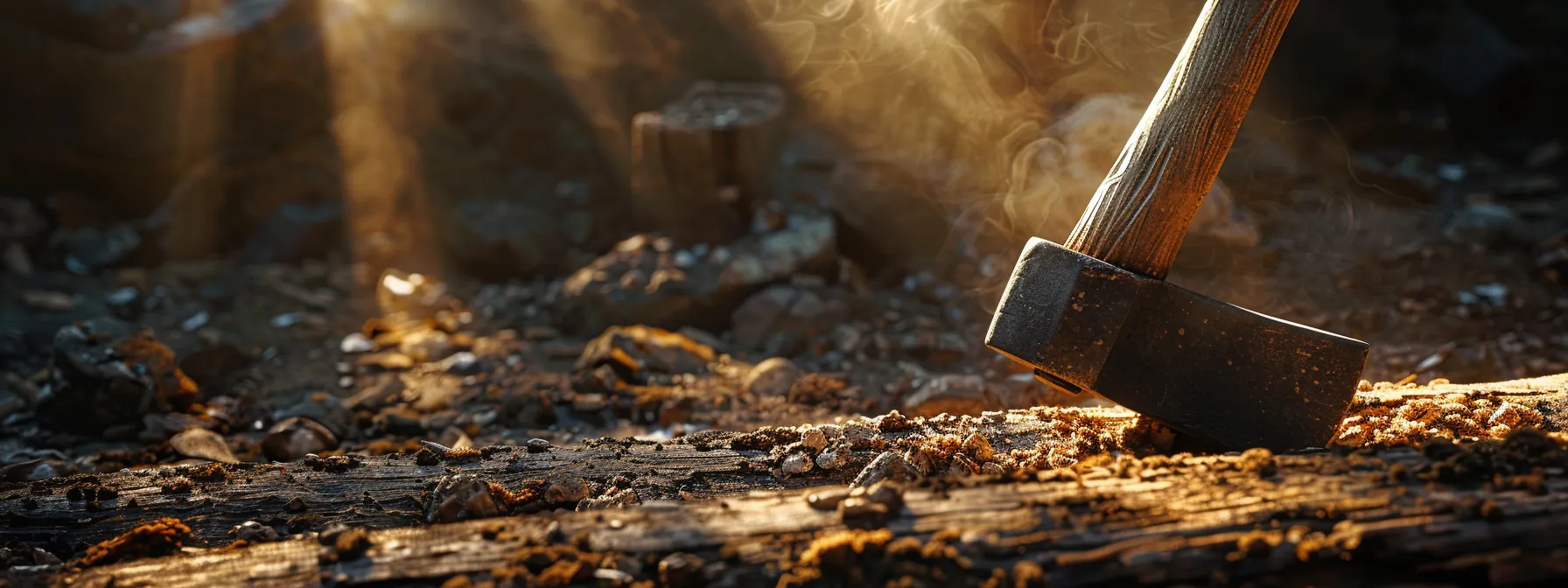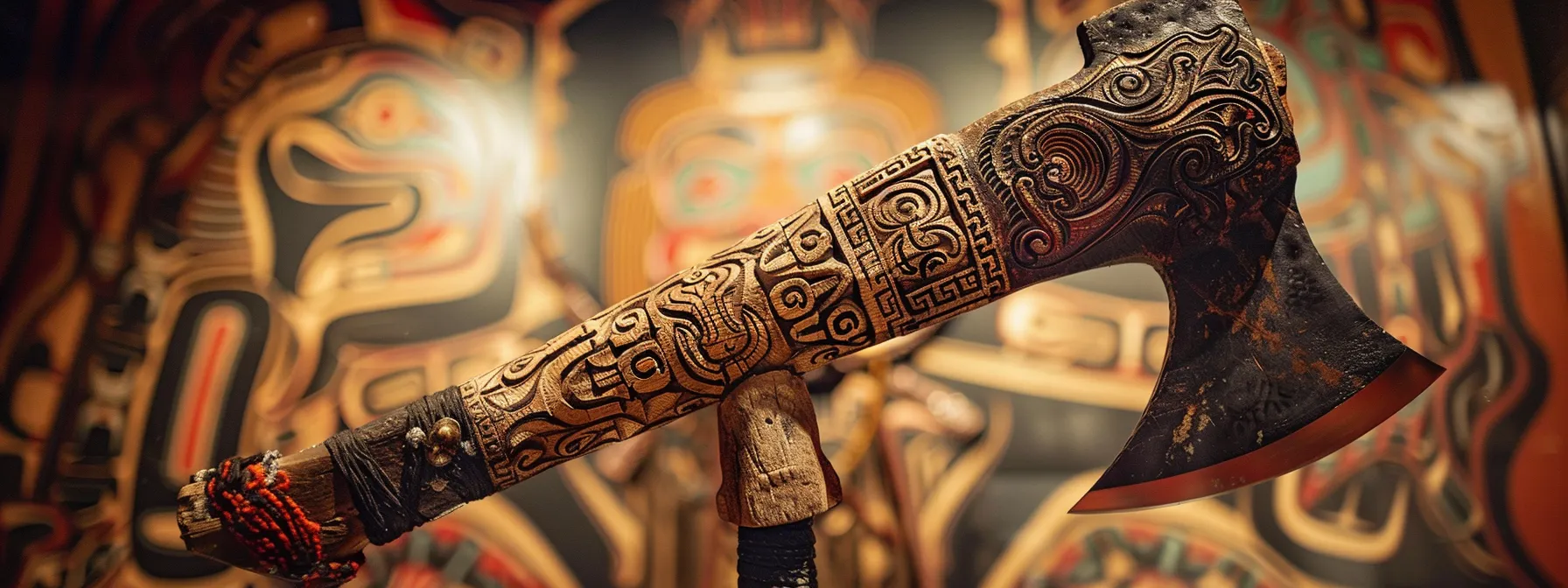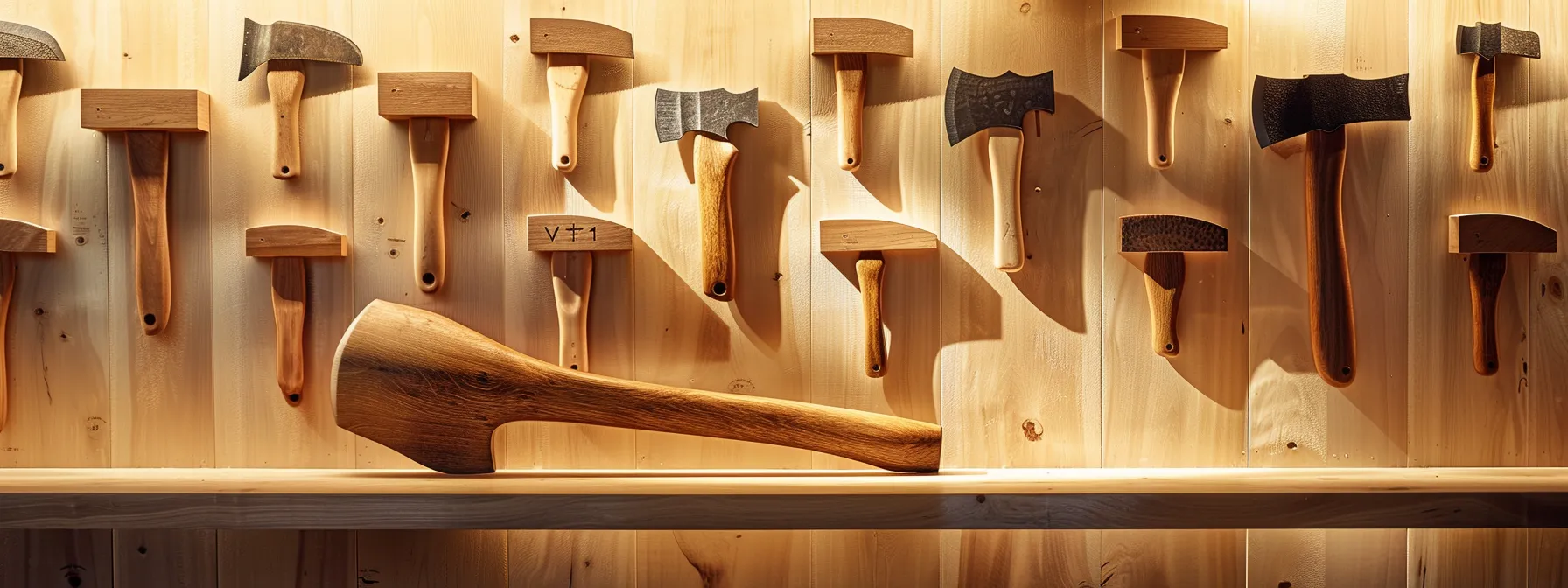Did you know that the evolution of axes has played a crucial role in shaping human civilization? From early stone tools to advanced bronze artifacts, axes have been central to our development and survival. This blog post will explore the origins of axes, their significance in warfare, and how innovations in hafting techniques have changed their design over time. By understanding this history, you'll gain insight into the importance of these tools and improve your appreciation for their impact on human progress. Whether you're a woodworker or simply curious about outdoor tools, this exploration will deepen your knowledge and enhance your skills.
Key Takeaways
- The evolution of axes transformed human societies by enhancing hunting and resource management
- Metal axes offered improved durability, significantly impacting construction and agricultural practices
- Axes symbolize power and status across cultures, influencing social hierarchies throughout history
- Specialized axe designs enhanced their effectiveness for various practical applications and tasks
- Ancient innovations in axe-making continue to inform modern tool design and craftsmanship today
The Origins of Axes in Early Human Societies

The creation of stone axes marked a pivotal moment in early human societies, enabling more efficient hunting and gathering practices. As we moved from simple stone tools to hafted axes, like the halberd and splitting maul, our ability to manipulate resources evolved. These advances influenced not just our survival strategies but also social structures, as archaeological discoveries of early axes reveal their role in shaping communities focused on pine and leaf usage, among others.
Creation and Use of Stone Axes
The creation of stone axes was a significant milestone in human evolution, providing early societies with versatile tools for various tasks. By shaping antler or stone into blades and binding them to wooden handles, our ancestors could effectively chop wood, hunt game, and prepare resources for survival. As these axes evolved during the Bronze Age, particularly in regions like Central Europe, they began to reflect advancements in technology and societal organization, highlighting their pivotal role in shaping daily life and community structures.
Development of Hafted Axes
The development of hafted axes marked a transformative chapter in tool-making that enhanced human efficiency in various tasks. By integrating sharper blades—often crafted using Acheulean techniques—onto sturdy wooden handles, our ancestors improved the anatomy of the tool itself, leading to increased power and precision. This evolution not only optimized daily activities, such as woodcutting for shelter and firewood but also influenced early architecture, allowing communities to construct more durable structures and even advance firefighting techniques through better resource management.
Impact on Hunting and Gathering Practices
The introduction of axes significantly altered hunting and gathering practices in early societies. With tools like stone hammers and the later development of copper axes, our ancestors could process animals and plants more efficiently, facilitating the domestication of certain species. Additionally, their use extended beyond practical applications; axes became symbolic, particularly in religious contexts, serving as fasces in rituals that underscored social hierarchy and community cohesion.
Influence on Social Structures
The evolution of axes from basic stone tools to more advanced versions, like the battle axe used during the Roman Empire, played a crucial role in shaping social structures within early human societies. As communities developed, these tools became indicators of status and power, influencing hierarchies based on access to resources and combat effectiveness. Understanding the biology of materials used, such as the transition from stone to steel, not only illustrates the craftsmanship involved but also reflects the interconnectedness of technology and social dynamics in human civilization.
- The transition from simple stone tools to hafted axes enabled greater efficiency.
- Advanced uses of axes allowed communities to develop sophisticated hunting and gathering practices.
- Axes became symbols of power and status, influencing social hierarchies.
- Materials evolved from stone to steel, showcasing advancements in technology.
- Tools like the battle axe played significant roles in warfare, reflecting social organization.
Archaeological Discoveries of Early Axes
Archaeological discoveries of early axes have provided invaluable insights into ancient human societies, highlighting their connection to essential activities such as hunting, wood processing, and even mining. These artifacts not only demonstrate the technological advancements tied to bipedalism and tool use but also reflect cultural nuances; for example, axes were often designed with specific features, like a tooth-like edge, to enhance cutting efficiency. Findings also suggest a correlation between these tools and the lifestyle of communities, including the Franks, enhancing our understanding of their social hierarchies and survival strategies.
- Early axes were essential for practical tasks like chopping wood and hunting.
- Archaeological findings indicate variations in axe design based on regional needs.
- Axes reflect advancements related to bipedalism and social structures.
- Tools were not just functional but also indicators of status within communities.
- Discoveries amongst the Franks shed light on their cultural practices and organization.
As early humans grew and learned, the tools they used evolved. The shift from stone to metal axes marked a new chapter in their quest for survival and progress.
Transition From Stone to Metal Axes

The transition from stone to metal axes marked a significant evolution in tool-making that transformed human civilization. Copper and bronze axes introduced advanced metalworking techniques, enhancing durability and effectiveness for hewing and chopping. Iron axes further improved performance, spreading across civilizations through trade, which facilitated the exchange of axe technologies and refined hand tools like adzes and chisels. Each of these advancements has played a crucial role in shaping our historical landscape.
Introduction of Copper and Bronze Axes
The introduction of copper and bronze axes marked a transformative moment in the evolution of human tools and significantly impacted agriculture and trade practices. These metal axes offered greater durability and efficiency for tasks such as clearing land for farming and crafting pottery, enhancing productivity across societies. During the Iron Age, the development of iron axes further advanced tool-making techniques, which improved not only woodcutting efficiency but also the production capabilities for various crafts, guiding communities toward a more structured approach to resource management and societal growth.
Advancements in Metalworking Techniques
The advancements in metalworking techniques had a profound impact on the evolution of axes and subsequently the progression of human civilization. As cultures began to adopt metals like copper, bronze, and iron, the creation of stronger and more versatile tools emerged. This evolution allowed for the development of heavier chopping tools that facilitated tasks such as woodcutting, which was essential for building and crafting, thus enhancing daily life and productivity—qualities that are just as relevant when considering modern tools like chainsaws and hacksaws. Additionally, these innovations set the stage for the eventual creation of weapons, including swords, reflecting the intertwining of tool-making and warfare that shaped societies and their power structures throughout history.
Iron Axes and Their Enhanced Durability
Iron axes represent a significant advancement in tool technology, offering enhanced durability that surpassed their flint and stone predecessors. As societies transitioned from primitive tools to these robust instruments, the ability to efficiently process lumber and tackle larger species of trees became possible. This improvement not only facilitated construction projects but also allowed for the creation of figurines and other wooden artifacts that reflected the culture of places like Crete.
- Iron axes provided a stronger alternative to flint and stone tools.
- Increased durability allowed for more efficient lumber processing.
- Facilitated construction of structures and crafting of wooden figurines.
- Enabled communities to manage larger species of trees, expanding their resources.
- Contributed to cultural development in regions like Crete.
Spread of Metal Axes Across Civilizations
The spread of metal axes across civilizations marked a significant milestone in human history, particularly during the Mesolithic and into the Middle Ages. Research indicates that as metalworking techniques advanced, societies began to produce axes with stronger handles and sharper blades, greatly enhancing their utility in daily tasks. This evolution not only facilitated more effective resource management, allowing communities to clear forests and construct shelters, but it also left its mark in rock art, where depictions of these tools reflect the integral role they played in shaping cultural identities.
- Emergence of metal axes influenced agricultural and construction practices.
- Research highlights the transition from stone to metal tools during the Mesolithic period.
- Axes became essential for resource management and societal growth throughout the Middle Ages.
- Rock art provides visual evidence of the importance of axes in ancient cultures.
Exchange of Axe Technologies Through Trade
The exchange of axe technologies through trade fundamentally transformed human societies, enhancing fields such as carpentry and timber framing. As communities exchanged metal axes, they not only improved their toolmaking skills but also facilitated the development of various industries, including weaving and agriculture related to plants like poaceae. This interconnectivity influenced archaeological findings, revealing how the spread of advanced tool technologies shaped cultural identities and social hierarchies across regions.
- The transition from stone to metal axes enhanced tool-making techniques.
- Communities benefited from improved carpentry and timber framing through trade.
- Exchanges connected diverse practices, including weaving and agriculture.
- Archaeological findings illustrate the cultural impacts of axe technologies.
- Trade networks played a vital role in spreading innovations across civilizations.
With the rise of metal axes, humans gained more than just a better tool; they unlocked new potential. These axes became essential, shaping communities and driving progress in ways that stone never could.
Axes as Essential Tools for Development

Axes played a transformative role in the emergence of early civilizations, facilitating agriculture and land clearing, essential for crop production. They contributed significantly to building and construction, enabling us to create more durable structures. In shipbuilding and exploration, hand axes were vital for crafting vessels, while efficient forest resource management leveraged these tools for economic growth within ancient communities. I will cover each area in detail to showcase the invaluable impact axes have had on our development.
Role in Agriculture and Land Clearing
Axes, specifically hatchets and tomahawks, have historically played a crucial role in agriculture and land clearing. These tools facilitated logging, allowing early societies to clear vast areas of land for cultivation, which was essential for growing crops like wool-producing plants. By enabling effective land management, axes not only supported food production but also contributed to the common descent of agricultural practices that shaped various civilizations throughout history.
Contribution to Building and Construction
Axes have significantly contributed to building and construction throughout human history, laying the foundation for developing societies. For instance, archaeological sites such as the Olduvai Gorge and Blombos Cave demonstrate how these tools allowed early humans to construct shelters and process materials for various structures. From the introduction of the ice axe for traversing rugged terrains in Wales to the crafting of sturdy beams and timber for homes, the evolution of axes has been pivotal in shaping our built environment.
- The role of axes in early shelter construction.
- Use of axes at Olduvai Gorge and Blombos Cave.
- Benefits of ice axes in rugged terrains like Wales.
- Development of tools for crafting timber beams.
- Overall impact on societal progression through construction.
Use in Shipbuilding and Exploration
The use of axes in shipbuilding and exploration has been critical in enabling ancient societies to expand their realms. Tools like the dane axe and the mattock were instrumental in crafting robust ships from available resources, allowing these communities to navigate rivers and seas effectively. My knowledge of paleolithic techniques reveals that as iron became more prevalent, the durability of these tools improved, not only enhancing ship construction but also facilitating trade and exploration that laid the groundwork for future civilizations:
- Axes were essential in crafting sturdy ships for exploration.
- The dane axe and mattock played key roles in shipbuilding activities.
- Advancements in iron tools increased durability and efficiency.
- Exploration aided in trade and cultural exchange.
- Paleolithic techniques inspired modern craftsmanship in maritime construction.
Management of Forest Resources
The management of forest resources during the Stone Age involved using axes as vital tools for woodworking and wood processing. These early humans relied on sturdy stone axes to clear land and harvest timber, ensuring they could create shelters and gather materials necessary for survival. As metalworking progressed, the innovation of metal axes further enhanced our ability to manage forestry, allowing for more efficient harvesting techniques and better resource control that laid the groundwork for sustainable practices in prehistory.
Economic Impact on Ancient Communities
The economic impact of axes on ancient communities was profound, as these versatile tools facilitated hunting and resource management. By employing axes, our ancestors could effectively process large mammals and clear land for agriculture, which directly contributed to food security and overall community prosperity. Furthermore, specialized tools like the labrys—often characterized by a double-headed design—demonstrated advancements in metallurgy and efficiency, while the wedge shape of many axe heads allowed for easier splitting of wood, essential for building shelters and crafting essential items.
- Axes improved hunting efficiency by allowing better processing of large mammals.
- These tools enabled land clearing for agriculture, enhancing food security.
- The labrys exemplified innovations in axe design and metallurgy.
- The wedge shape of axe heads facilitated wood splitting for building resources.
- Axes contributed significantly to the economic prosperity of ancient communities.
Axes shaped civilizations, carving wood and forging communities. Yet, in darker times, these tools became weapons, altering the very fabric of warfare and defense strategies.
The Axe in Warfare and Defense Strategies

Axes served as essential weapons in ancient conflicts, shaping military tactics and equipment throughout history. I will explore notable historical battles where axes played a critical role, variations of battle axes among different cultures, and how these tools influenced the development of defensive measures. Understanding the context of battle axes, including types like the throwing axe and pickaxe, reveals their significant impact on warfare and defense strategies.
Utilization as Weapons in Ancient Conflicts
In ancient conflicts, the axe emerged as a formidable weapon, particularly during the late Stone Age and Neolithic periods. These tools were not only used in battles for their cutting efficiency but also played a significant role in the construction of defensive structures. My research on figures like Lucy, who symbolized early human ingenuity, highlights how axes were critical in shaping both military strategies and everyday life, effectively bridging the gap between utilitarian tools and weapons of war.
Influence on Military Tactics and Equipment
The influence of axes on military tactics and equipment can’t be overstated, particularly in how they shaped combat practices in ancient societies. For instance, the use of wooden axes in military engagements allowed warriors to effectively break through defenses crafted with clay or reinforced with wood. Additionally, the design of structures utilizing mortise and tenon joints provided robust roofs, enhancing fortifications and enabling armies to establish strategic positions that were harder to breach in skirmishes.
Notable Historical Battles Involving Axes
Throughout history, notable battles have showcased the critical role of axes alongside more traditional weapons like spears. For example, during the early Oldowan period, axes were essential for close combat, providing both offensive and defensive capabilities when engaging in conflicts. The transition to metal axes further enhanced their effectiveness, allowing warriors to wield weapons that could inflict severe damage, as reflected in cross section analyses of ancient remains and carbon dating of artifacts discovered at battle sites. Understanding these historical contexts illustrates how axes not only served as tools for survival but also as significant instruments of warfare that shaped societal structures.
Variations of Battle Axes Among Cultures
Across various cultures, the design and use of battle axes have evolved significantly, reflecting the unique needs and resources of each society. For instance, the palstave was a typical type of axe used in Europe, known for its distinctive shape and practicality during conflicts. In contrast, the broadaxe, recognized for its wide, flat blade, became essential in shaping timber for building fortifications in ancient construction. Additionally, I have often noted how the introduction of materials like fiberglass in modern axes has transformed their durability and efficacy, bridging ancient techniques with contemporary advancements in tool-making.
- Cultural differences influence the design of battle axes, such as the palstave in Europe.
- The broadaxe served a critical role in timber shaping for defense structures.
- Modern materials like fiberglass enhance the performance of axes.
- Ancient designs continue to inform contemporary tools, reflecting their lasting impact.
Development of Defensive Measures in Response
The development of defensive measures in response to threats was significantly influenced by the use of axes in ancient societies. As environments became more competitive, communities, including Neanderthals, leveraged the effectiveness of axes to build fortifications and barriers for protection. Utilizing axes for tasks such as felling trees not only provided firewood but also contributed to creating defensive structures, allowing for a more secure living environment.
- Ancient societies utilized axes to build fortifications.
- Neanderthals demonstrated the use of axes in defensive strategies.
- Efforts to gather firewood aided in constructing protective barriers.
- Axes enabled improved security in competitive environments.
The axe was more than a tool of war; it carved power and meaning into the hearts of communities. From battlefields to sacred rituals, its presence told stories that go beyond survival.
Cultural and Symbolic Significance of Axes

Axes hold profound cultural and symbolic significance across various societies. They often feature prominently in myths and legends, illustrating their representation of power and strength. Additionally, axes are integral to ceremonial and ritualistic practices, reflecting leadership roles. Their depictions in ancient art and literature highlight their enduring presence, while the preservation of traditions related to axes ensures their legacy endures in modern culture.
Representation in Myths and Legends
Axes have been featured in numerous myths and legends across cultures, symbolizing power, strength, and the embodiment of human ingenuity. For example, in Norse mythology, Thor's hammer, Mjölnir, while not an axe, represents the might and protection of the gods, reflecting how bladed tools were perceived as instruments of divinity and authority in ancient societies. These stories not only highlight the practical utility of axes in everyday life but also reinforce their status as symbols of leadership and civilization’s advancement:
- Norse myths often depict axes as weapons wielded by heroic figures.
- In various cultures, axes symbolize strength and protection.
- Folklore frequently highlights the importance of axes in overcoming challenges.
- Legends illustrate how powerful leaders used axes in war and peace.
Ceremonial and Ritualistic Importance
Axes have long held ceremonial and ritualistic importance across various cultures, often serving as symbols of power and status. In many ancient societies, axes were integrated into rituals that celebrated harvests, victories in battle, or seasonal changes. By using axes in these ceremonies, communities reinforced social cohesion and showcased their technological advances, thus illustrating how these tools transcended mere practicality to become vital elements of cultural identity.
Symbolism of Power and Leadership
Throughout history, axes have been more than just tools; they have functioned as powerful symbols of authority and leadership. In many ancient societies, possession of a finely crafted axe often indicated a person's social status or role as a leader, particularly in times of conflict. This symbolism is still relevant today, as axes represent not only physical strength but also the skills required to lead communities through challenges, reinforcing the connection between craftsmanship and leadership:
- Axes symbolize authority in ancient cultures, representing power and leadership.
- Possession of an axe often indicated social status and a role in warfare.
- Craftsmanship in axe-making demonstrates the skills necessary for effective leadership.
- Axes still resonate today as symbols of strength and resilience in overcoming challenges.
Depictions in Ancient Art and Literature
In ancient art and literature, axes often symbolize strength, authority, and the advancement of civilization. For instance, cave paintings frequently depict figures wielding axes, signifying their importance in everyday life and asserting their role in both survival and community leadership. These artistic representations not only emphasize the practical use of axes as tools for resource management but also reflect cultural values and social hierarchies, illustrating how integral these instruments were to the evolution of human societies.
Preservation of Traditions Related to Axes
The preservation of traditions related to axes plays a vital role in maintaining cultural identity and craftsmanship. Many communities still participate in rituals that involve axes, often using them in ceremonies that celebrate life events, agricultural cycles, or communal achievements. By passing down these practices, we not only keep the art of axe-making alive but also reinforce the connection between tools and the values they represent, such as strength, resilience, and community cohesion.
Axes have always held great meaning, wielding power beyond their sharp edges. But as time passed, the design and technology behind these tools transformed, adapting to meet the needs of each new generation.
Evolution of Axe Design and Technology

The evolution of axe design and technology has profoundly shaped human civilization. I will explore innovations in axe head shapes and styles, along with advances in materials and craftsmanship that enhanced their durability. I will also discuss the creation of specialized axes tailored for various tasks, their influence on modern tool-making techniques, and the enduring legacy these ancient tools hold in today's world.
Innovations in Axe Head Shapes and Styles
The innovations in axe head shapes and styles have played a critical role in enhancing the functionality and efficiency of these tools throughout history. I have observed how the evolution from simple, rounded blades to more specialized shapes, such as bearded and double-bit designs, has allowed users to tackle a wider variety of tasks, from felling trees to carving wood. These advancements not only improved cutting performance but also made axes more versatile for different applications, meeting the evolving needs of woodworkers, farmers, and outdoor enthusiasts alike.
Advances in Materials and Craftsmanship
Advances in materials and craftsmanship have been crucial in the evolution of axes, enhancing their functionality and durability. Early axes evolved from simple stone and wood constructions to more robust designs featuring metals like bronze and iron. I’ve observed that the development of specialized techniques, such as tempering and alloying, not only improved the strength of the axe heads but also allowed for more precise cutting edges, making these tools invaluable for woodworking, agriculture, and even survival situations.
Creation of Specialized Axes for Various Tasks
The creation of specialized axes for various tasks illustrates the adaptability of human innovation in tool-making. Over time, we have developed axes tailored for specific applications, such as splitting mauls for efficiently breaking wood apart or hatchets designed for precise carving and shaping. This specialization not only enhanced effectiveness in tasks like woodworking and farming but also underscored the importance of axes in advancing agricultural practices and resource management throughout history.
Influence on Modern Toolmaking Techniques
The evolution of axe design has directly influenced modern toolmaking techniques, particularly in terms of material innovation and craftsmanship. For instance, the transition from rudimentary stone tools to sophisticated metal designs reflects advancements in metallurgical processes that continue to impact today’s manufacturing methods. As I work with contemporary axes and other cutting tools, I often see how principles established by ancient craftsmen are applied, such as balance, weight distribution, and blade geometry, which remain vital for enhancing cutting efficiency and user experience.
Enduring Legacy of Ancient Axes in Today's World
The enduring legacy of ancient axes is evident in modern cutting tools, which retain the fundamental design and functionality that our ancestors developed. Today’s axes, hatchets, and tomahawks draw on centuries of craftsmanship, showcasing improved materials such as steel and advanced ergonomics that enhance efficiency and comfort during use. As I work with various cutting tools, I appreciate how the innovations inspired by ancient designs continue to meet the needs of woodworkers, outdoor enthusiasts, and survivalists alike:
- Modern axes reflect centuries of design evolution, focusing on efficiency and usability.
- Today’s materials, like steel, offer improved performance compared to their ancient counterparts.
- Functional designs are rooted in traditional craftsmanship that influences contemporary tool-making.
- Axes remain essential for various applications, proving their lasting importance in society.
Conclusion
Ancient axes significantly shaped human civilization, revolutionizing agriculture, construction, and resource management. Their evolution from simple stone tools to advanced metal designs reflects our technological progress and innovations in craftsmanship. By facilitating survival and enhancing social structures, axes became symbols of power and community identity. Understanding their impact helps us appreciate the foundational role these tools play in modern societies, ensuring their legacy continues in today's world.













































Leave a comment (all fields required)